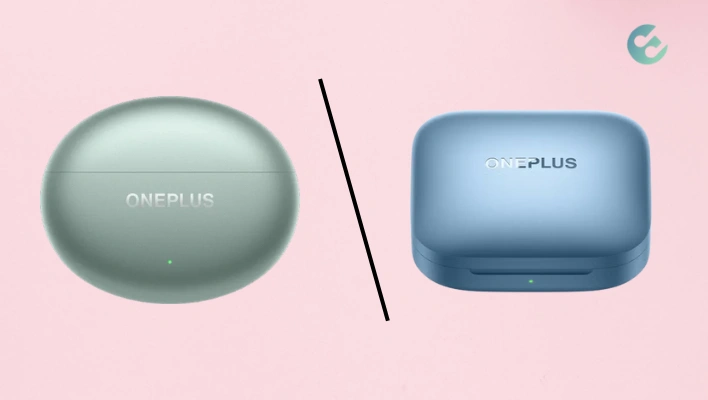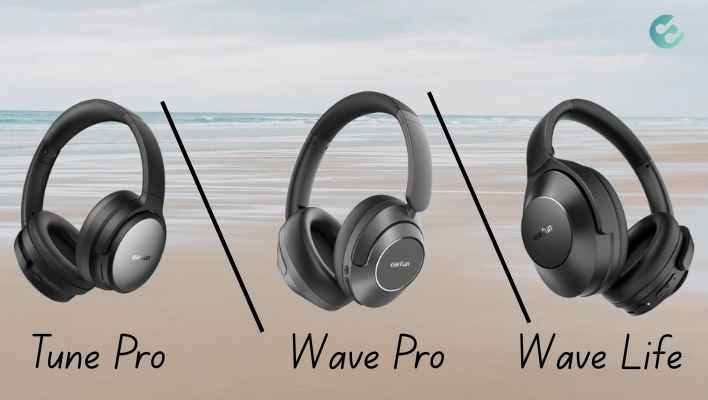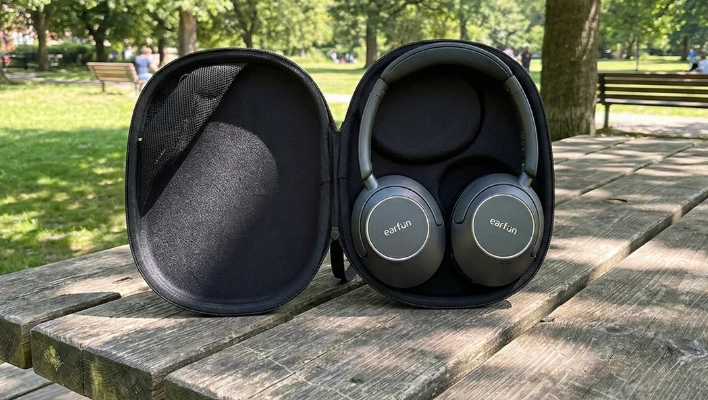OnePlus just expanded their earbuds lineup by introducing the sleek new Buds 4, launched on July 8, 2025, with a price tag of $129.99.
But how do they stack up against the fan-favorite Buds 3, which hit the market at a more wallet-friendly $99?
With the Buds 4 boasting upgrades like enhanced noise cancellation and a refined fit, you might be wondering: should you upgrade, or is the Buds 3 still the better value for money?
In this article, I’ll compare the design, sound quality, features, and more to help you pick the perfect pair for your needs.
Design and Comfort
Both Buds 4 & 3 look different. The Buds 3 sport a sleek, flat pebble-shaped case with a matte finish and a chrome OnePlus logo that screams understated elegance. At 40.8g, the case feels solid yet lightweight, with a sturdy hinge that holds up well. The earbuds themselves, weighing 4.8g each, feature a two-tone glossy and matte finish, complete with soft silicone tips (three sizes included) for a snug, comfortable fit during long listening sessions.
The Buds 4, on the other hand, borrow a page from the premium Buds Pro 3, opting for a horizontally opening pebble-shaped case that’s even lighter at 40g and impressively compact (65.4 x 52.4 x 25.3mm). However, some might find its “soap bar” aesthetic less charming than the Buds 3’s refined look. The earbuds, at 4.73g, are marginally lighter and come in black or green, maintaining the stem design with an IP55 rating for dust and water resistance. The fit is a step up, feeling more secure and comfortable for extended wear, though slotting them back into the case can be a bit fiddly.

One downside with the Buds 4 is the touch controls. While both models use tap gestures for playback and ANC switching, the Buds 4’s swipe-to-adjust-volume feature on the stem often requires a heavy touch, which can nudge the buds out of place.
The Buds 3 handle this better with more responsive controls, making them easier to use on the go.
Winner: Buds 3 for a classier case and better controls, but Buds 4 take the edge for comfort.
Sound Quality
Both are solid in this department, but there are subtle differences. The Buds 3 feature a dual-driver setup (10.4mm woofer + 6mm tweeter) arranged coaxially, delivering a punchy, V-shaped sound with strong bass and treble. The “Serenade” preset in the HeyMelody app balances things out by boosting mids, making vocals and instruments pop without overwhelming bass. While the LHDC 5.0 codec supports high-res audio, pushing bitrates to 1Mbps can lead to stuttering, so you’re often stuck with stable but lower 400-500kbps.

The Buds 4 step things up with an 11mm woofer + 6mm tweeter and a dual DAC setup, which refines the audio experience. The bass is still front and center, but treble and vocals are clearer, especially at volumes below 70%. Crank it past that, and the bass can drown out details, which might disappoint those seeking crisp clarity. The Golden Sound feature, which tailors EQ based on your ear canal and hearing, adds a nice touch, though the improvements are subtle. Like the Buds 3, the Buds 4 support LHDC 5.0 and Hi-Res Audio Wireless (up to 192kHz), but high bitrates remain finicky.
Winner: Buds 4 for slightly better treble and vocal clarity, but the difference isn’t night-and-day.
Noise Cancellation and Transparency
In terms of ANC, Buds 4 are slightly ahead. The Buds 3 offer solid ANC with up to 49dB noise reduction, effectively muting low-frequency hums and handling mids and highs decently. You can toggle between Max, Moderate, and Mild settings, with a Smart mode that adjusts automatically. The transparency mode is functional, letting in ambient sounds like announcements without feeling artificial.
The Buds 4 take ANC to another level, boasting up to 55dB noise reduction. In real-world tests, the High ANC mode creates a near-silent bubble, blocking out everything from gym chatter to street noise. With multiple modes (High, Moderate, Low, Auto, and Adaptive), you have plenty of control. The transparency mode is slightly improved, offering clearer passthrough, but it’s not a massive leap over the Buds 3.
Winner: Buds 4, hands-down, for best-in-class ANC that rivals pricier competitors.
Features and Connectivity
Both earbuds use the HeyMelody app for customization, but the experience differs. The Buds 3 support Bluetooth 5.3 with SBC, AAC, and LHDC 5.0 codecs, offering dual device pairing. However, switching between devices doesn’t pause playback automatically, which can be annoying. Features include a 6-band custom EQ, BassWave for bass tweaks, Golden Sound, and 3D Audio (no head-tracking). The Game mode reduces latency to 94ms, ideal for mobile gaming. The app is reliable but clunky on OnePlus phones, where settings are buried deep.
The Buds 4 upgrade to Bluetooth 5.4, keeping the same codec support and dual pairing. New features include OnePlus 3D Audio (Spatial Audio), camera control via buds, and a find-my-earbuds tool. However, the HeyMelody app is a letdown, with frequent connectivity issues—buds often need re-adding, and navigating to settings is a hassle. The AI translation mode, exclusive to select OnePlus phones, feels like a gimmick for most users. Like the Buds 3, automatic play/pause during device switches is absent, which stings more at the higher price.
Winner: Buds 4 for a broader feature set, but the app issues make the Buds 3’s simpler experience more reliable.
Call Quality
The Buds 3 deliver clear, artifact-free calls with excellent background noise suppression, even in noisy settings. A neat feature routes audio to your phone’s earpiece or speaker when you remove the buds during a call, making transitions seamless.
The Buds 4 match this performance indoors but pull ahead outdoors, where they better isolate your voice in noisy environments like busy streets. The same audio-routing feature is present, keeping calls smooth.
Winner: Buds 4 for a slight advantage in outdoor clarity, but both are strong performers.
Battery Life
Battery life is nearly identical. The Buds 3 offer up to 10 hours (AAC, ANC off) or 6.5 hours (ANC on) per charge, with the case providing 44 hours total.
The Buds 4 claim 11 hours (ANC off) or 6 hours (ANC on), with 45 hours total from the case.
Winner: Tie—negligible differences make them equally dependable.
OnePlus Buds 4 vs OnePlus Buds 3: Specs Comparison
| Feature | OnePlus Buds 4 | OnePlus Buds 3 |
|---|---|---|
| Price (USD/GBP/AUD) | $129.99 / £119 / ~AU$200 | $99 / £89 / ~AU$179 |
| Release Date | July 8, 2025 | January 2024 |
| Driver Setup | Dual drivers (11mm woofer with 30-layer ceramic-metal diaphragm, 6mm flat-diaphragm tweeter) | Dual drivers (10.4mm woofer, 6mm tweeter) |
| Digital-to-Analog Converter (DAC) | Dual DAC (one for each driver) | Single DAC |
| Bluetooth Version | Bluetooth 5.4 | Bluetooth 5.3 |
| Audio Codecs | SBC, AAC, LHDC 5.0 (up to 24-bit/192kHz) | SBC, AAC, LHDC 5.0 |
| Active Noise Cancellation (ANC) | Up to 55dB, Adaptive ANC, 3 levels, 200% better voice cancellation vs. Buds 3 | Up to 49dB, 3 levels |
| Transparency Mode | Yes, with Adaptive Mode (dynamically switches between ANC and Transparency) | Yes |
| Battery Life (Earbuds, ANC Off) | Up to 11 hours (62mAh per bud) | Up to 10 hours (58mAh per bud) |
| Battery Life (With Case, ANC Off) | Up to 45 hours (530mAh case) | Up to 44 hours (520mAh case) |
| Battery Life (Earbuds, ANC On) | Up to 6 hours | Up to 6.5 hours |
| Battery Life (With Case, ANC On) | Up to 24 hours | Up to 28 hours |
| Charging Time | 10 min charge for 11 hours (with case), full charge in ~1 hour | 10 min charge for 9-10 hours (with case), full charge in ~1 hour |
| Wireless Charging | No | No |
| Low Latency Mode | 47ms | 94ms |
| Microphones | 3-mic system with AI Clear Call algorithm | 3-mic system |
| IP Rating | IP55 (dust and water resistance) | IP55 (dust and water resistance) |
| Weight (Per Bud / Case) | ~4.8g per bud / 40g case | ~4.8g per bud / 40g case |
| Case Design | Pebble-shaped, matte finish, 65.4 x 52.4 x 25.3mm | Rectangular clamshell, glossy finish |
| Controls | Touch controls (tap and swipe for volume, customizable via HeyMelody app) | Touch controls (tap and swipe for volume, customizable via HeyMelody app) |
| Additional Features | OnePlus 3D Audio, Golden Sound EQ, AI translation (OnePlus phones), multipoint connectivity, Google Fast Pair, in-ear detection | OnePlus 3D Audio, graphic EQ, multipoint connectivity, Google Fast Pair, in-ear detection |
| Colors | Black, Green | Splendid Blue, Metallic Gray |
Which Should You Choose?
Buy the OnePlus Buds 4 if:
- You need top-notch ANC to block out noisy environments.
- Comfort is a priority for long listening sessions.
- You can snag them on sale or as a freebie with a OnePlus phone.
Buy the OnePlus Buds 3 if:
- You want a premium design and reliable controls on a budget.
- You’re happy with very good (but not class-leading) ANC.
- Value for money is your top concern.
The OnePlus Buds 4 are a solid step forward, particularly in noise cancellation and comfort, making them a top pick for commuters or gym-goers who need silence.
However, the less premium design, finicky controls, and frustrating app hold them back from perfection.
The Buds 3, with their elegant look and reliable performance, remain a stellar value, especially if you’re watching your wallet.
Check out the latest deals:
Nick, the Co-founder of Earbuds Arena, is a seasoned freelance tech journalist with over ten years of experience covering wearables, apps, headphones, and gadgets. When he’s not immersed in the tech world, you’ll likely find him unwinding with video games, going for a run, or enjoying a game of soccer on the field.









